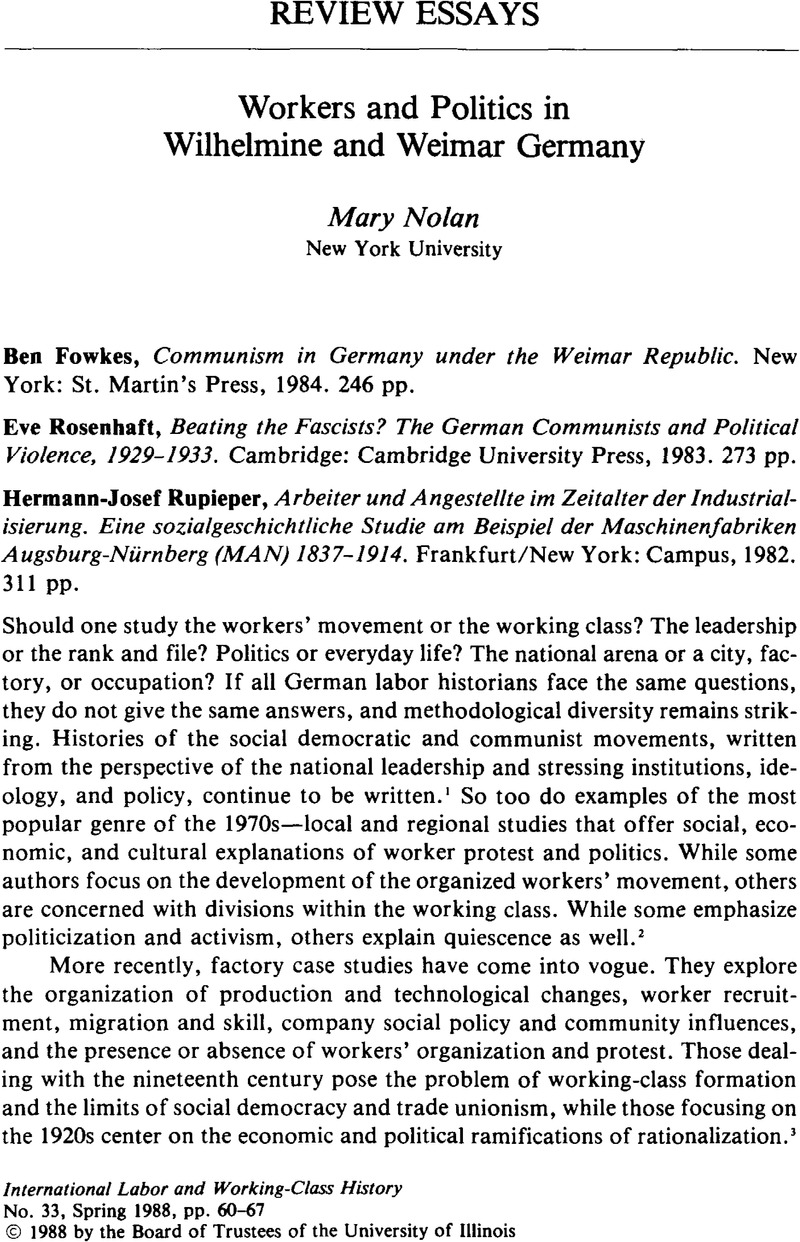No CrossRef data available.
Published online by Cambridge University Press: 16 December 2008

1. See, for example, Steenson, Gary P., “Not One Man! Not One Penny”: German Social Democracy, 1863–1914 (Pittsburgh, 1981).Google Scholar
2. See, for example, Crew, David, Town in the Ruhr: A Social History of Bochum, 1866–1914 (New York, 1979)Google Scholar; Nolan, Mary, Social Democracy and Society: Working-Class Radicalism in Düsseldorf, 1890–1914 (New York, 1981)CrossRefGoogle Scholar; von Saldern, Adelheid, Auf dem Wege zum Arbeiter-Reformismus. Parteialltag in sozialdemokratischen Provinz Göttingen, 1870–1920 (Frankfurt, 1984).Google Scholar Also, the review essay of Eley, Geoff, “Combining Two Histories: The SPD and the German Working Class Before 1914,” in Radical History Review 28–30 (1984): 13–44.CrossRefGoogle Scholar
3. For a sampling of the nineteenth-century studies, see Arbeiter im Industrialisierungsprozess, ed. Conze, Werner and Engelhardt, Ulrich (Stuttgart, 1979)Google Scholar; and Forschungen zur Lage der Arbeiter im Industrialisierungsprozess, ed. Pohl, Haus (Stuttgart, 1978).Google Scholar For the 1920s, see Schöck, Eva Cornelia, Arbeitslosigkeit und Rationalisierung. Die Lage der Arbeiter und die kommunistische Gewerkschaftspolitik, 1920–28 (Frankfurt, 1977)Google Scholar; and Stolle, Uta, Arbeiterpolitik imBetrieb. Frauen und Männer, Reformisten und Radikale, Fach-und Massenarbeiter bei Bayer, BASF, Bosch und in Solingen (1900–1933) (Frankfurt, 1980).Google Scholar
4. The German Working Class, 1888–1933, ed. Evans, Richard (London, 1982)Google Scholar; Lüdtke, Alf, “Organizational Order or Eigensinn? Workers' Privacy and Workers' Politics in Imperial Germany,” in Rites of Power: Symbolism, Ritual, and Politics Since the Middle Ages, ed. Wilentz, Sean (Philadelphia, 1985), 303–33Google Scholar; and “‘Deutsche Qualitätsarbeit,’ ‘Spielereien’ am Arbeitsplatz und ‘Fliehen’ aus der Fabrik: Industrielle Arbeitsprozesse und Arbeitsverhalten in den 1920 Jahren–Aspecte eines offenen Forschungsfeldes,” in Arbeiterkulturen zwischen Alltag und Politik, ed. Ball, Friedhelm (Vienna, 1986).Google Scholar
5. See, for example, the articles by Franzoi, Barbara, “Domestic Industry,”Google Scholar and Quataert, Jean, “Social Insurance and the Family Work of Oberlausitz Home Weavers in the Late Nineteenth Century,” in German Women in the Nineteenth Century, ed. Fout, John (New York, 1984), 256–94Google Scholar; Tröger, Annemarie, “The Creation of a Female Assembly-Line Proletariat,” in When Biology Became Destiny, ed. Bridenthal, Renate, Grossmann, Atina, and Kaplan, Marion (New York, 1984), 237–70.Google Scholar
6. See, for example, Working-Class Formation: Nineteenth-Century Patterns in Western Europe and the United States, ed. Katznelson, Ira and Zolberg, Aristide R. (Princeton, 1986).Google Scholar
7. Wickham, James, “Social Fascism and the Division of the Working Class Movement: Workers and Political Parties in the Frankfurt Area, 1929/1930,” Capital and Class 7 (Spring 1979): 1–34.CrossRefGoogle Scholar
8. See notes 3 and 7.